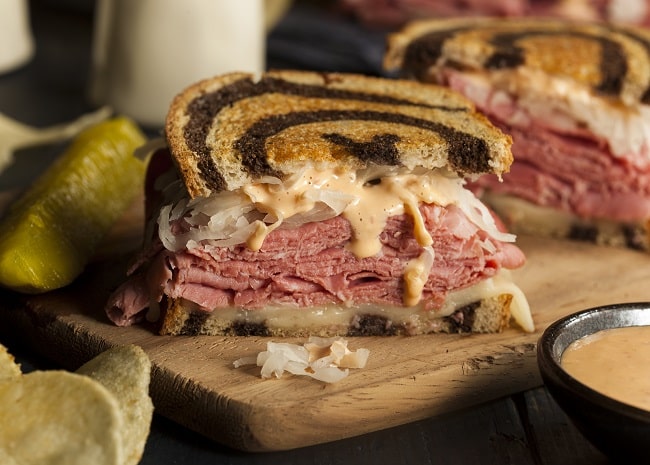As an Amazon Associate we earn from qualifying purchases.
Pastrami Vs Corned Beef – The Difference Between
If you are a fan of sandwiches, you may probably know the existence of the two amazing dishes on earth- Pastrami Vs Corned Beef. However, do you know how to tell the differences they have? Lucky you! After spending hours researching, I have collected some striking differences between them.
The following article will uncover Pastrami vs corned beef and the difference between them. Let’s check it out.
Pastrami Vs Corned Beef – Is Pastrami The Same As Corned Beef?
To get a thorough understanding of this topic, first of all, I will compare Pastrami vs. corned beef in terms of origins, meat cut types, spice mix, preparation, nutrition, and usage to answer the questions of “ Is pastrami the same as corned beef?”
READ ALSO: Difference Between Pork Steak and Pork Chop
Origin
As you know, Pastrami Vs Corned Beef are both suitable for sandwiches, but do you know where they are from or what are their roots?
To find the answer to this question, we have to look at the cuisine of European countries.
In the case of Pastrami, people said that there are two prospective “homelands.” Some people might argue that Pastrami originated in Romani, where its preceding brother- pastrami-a dish made with pork or mutton, was created by the locals.
Another place might be Pastrami’s home is from Turkey, where Pastrami is related to pastirma- a food made with beef. Whatever origins Pastrami has, we all agree that this food always brings us full of amaze whenever we take a bite.
Corned beef, on the other hand, has a much more simple origin. This food comes from Ireland. That is the reason why on St.Patrick’s Day, people can not forget corned beef as a traditional dish.
Meat Cuts – Ingredients
The next different feature the two dishes hold lies in the types of meat used to convert to Pastrami Vs Corned Beef.
The ingredients to make Pastrami Vs Corned Beef beef are kind of different. Corned beef, as the name suggests, is surely made of beef. And the main ingredient to make corned beef is usually brisket-the meat from the cow’s chest.
Pastrami is different from corned beef as people can substitute the ingredients with others. The use of ingredients is versatile, such as pork, mutton, turkey, or even beef( brisket). When you use brisket to make Pastrami, make sure you choose the navel end to make the best Pastrami.
Spice Mix
One of the things that Pastrami and corned beef share in common is the way they are brined. People often rub the meat cuts with salt or submerge them in saltwater to infuse the meat cuts’ flavor and make them moist.
However, things start to differ when you coat them with seasonings. After brining, Pastrami is often submerged in the mixture of black pepper, mustard seeds, coriander, garlic, and other spices. That coating process gives the food a dark brown look and increases the flavor of the dish.

While Pastrami is dressed with many seasonings, corned beef has nothing “put on.” So, no spices in corned beef.
You can be unique by adding herbs and other seasonings into your corned beef. But I do not recommend it because the taste can be ruined.
Cooking Method
Speaking of cooking methods, Pastrami Vs Corned Beef are different. Let’s see how.
The key thing to bear in mind is that Pastrami should be moist after cooking. That is why people often smoke it over hardwood near a pan of water to create steam and maintain the meat cuts’ moisture. Then people store it in cool places and steam it again before eating. Quite complicated, right?
Corned beef cooking method, in contrast, is simpler as all you need to do is to boil it. You can also cook it with cabbage to increase the flavors of the food.
Nutrition
The nutrition facts of one serving( 3.5 ounces each) of the two dishes are pretty the same in calories, fat, and protein. However, cholesterol and sodium might be taken into account because they are different in each dish.
Normally, one serving of Pastrami contains approximately 60- 70 mg of cholesterol and 850-900 mg sodium, while one serving of corned meat has roughly 40-50 mg of cholesterol and 950-over 1000 mg of sodium.
These factors have little to do with what dish you choose.
How To Enjoy
After cooking, you can consume these foods right away.
To enjoy the true flavor of corned beef, you should eat it traditionally by combining it with a Reuben or cabbage and carrots.
You can also enjoy Pastrami in the same manner as corned beef, but without cabbage and adding mustard instead.
The thickness of the meat also influences your enjoyment. If the meat you cut is too thick, well, you know what I mean. Hence, prepare a sharp knife and be ready to perform a “paper-thin” cut.

Pastrami Vs Corned Beef: Which Better?
Now is the time to consider which is suitable for you. Well, the decision is yours. But one thing to note down is that corned beef, with the way of cooking, has little flavors compared to Pastrami because Pastrami, as said, often goes with many types of seasonings and dressings.
So, if you are a fan of flavorful, slow-smoked dishes, Pastrami is a thing you should not miss. Otherwise, you can opt for corned beef as everything about it is so simple from preparation, cooking, to others. And in case you do not like the herb, corned beef is a perfect choice.
How to cook Pastrami Beef
Pastrami beef is a dish that can be found in many homes. The abundance of spices and the leanness of the meat make this recipe both unique and appetizing. However, it is important to take precautions when completing this dish to ensure that you don’t give yourself food poisoning or salmonella. Ensure to cook your beef all the way through.
Ingredients:
- 1 flat piece of beef (2 lb)
- 1/2 cup pepper
- 5 tbsp paprika
- 3 tbsp mustard seed
- 3 tbsp brown sugar
- 1 tbsp onion granules
- 2 tsp garlic powder
- 4 tsp salt
- 2 bay leaves, crumbled
Procedure: Mix together the spices in a small bowl and set aside. Apply the spice mixture to the surface of both sides of your roast. Place it in a roasting pan or baking dish with a lid and roast it in a preheated oven at 350 degrees Fahrenheit for 2 hours, turning the meat halfway through cooking time. Allow this to rest before slicing across the grain to serve.
How to cook Corned Beef
Ingredients:
Corned beef brisket (large) – One per person
Corned beef spice packet – Just open the corned beef pack and dump it in the pot.
Water – As much as you put in your pot. Pot size doesn’t matter. If it all bubbled out, who cares? It’s not like you’re making a soup or anything stupid like that. Plus, it’s good for flavor!
Salt & pepper to taste – To taste means to put whatever amount of salt and/or pepper you want into your dish. Don’t be an idiot and just follow what I wrote if you don’t know how to cook. I mean come on now…
Directions:
1. First, open the packet.
- Dump the spice mix in the pot.
- Add water until it is just below your desired level of meatiness. This means don’t have too much water since you will be boiling it for a while and most of the water will boil off… so don’t put too much or else your meal will turn out with not that much flavor. If you aren’t sure, then just follow this general rule: Corned beef is salty, so if you are cooking an entire big ass-sized piece of corned beef brisket, then add at least two cups of water (or more).
In A Nutshell
Hopefully, this article has provided you with insight into Pastrami vs corned beef-the difference between Pastrami Vs Corned Beef.
The difference is evaluated based on the following grounds: the origins, the meat cuts, the spice mix, the cooking methods, the usage, and the nutrition.
I hope you can find your favorite one.
Thanks for reading!



